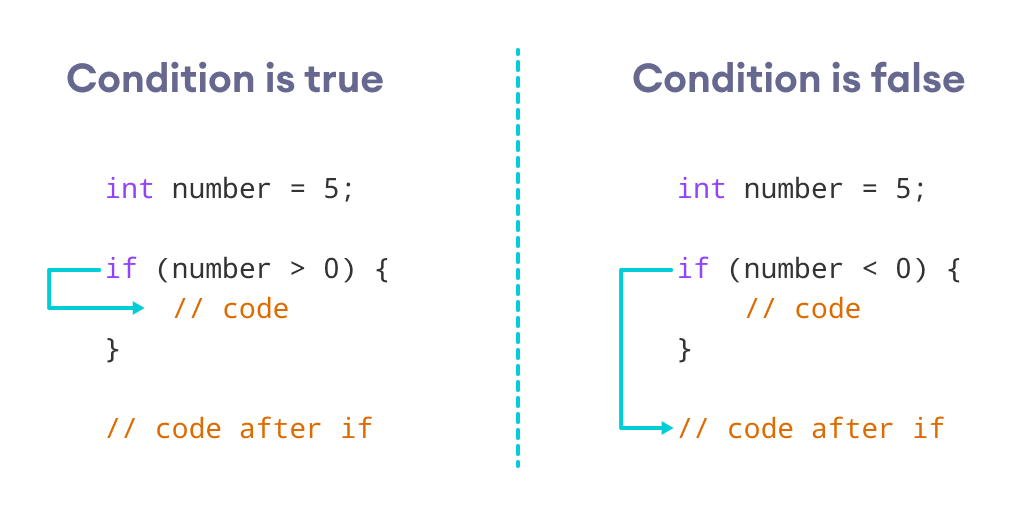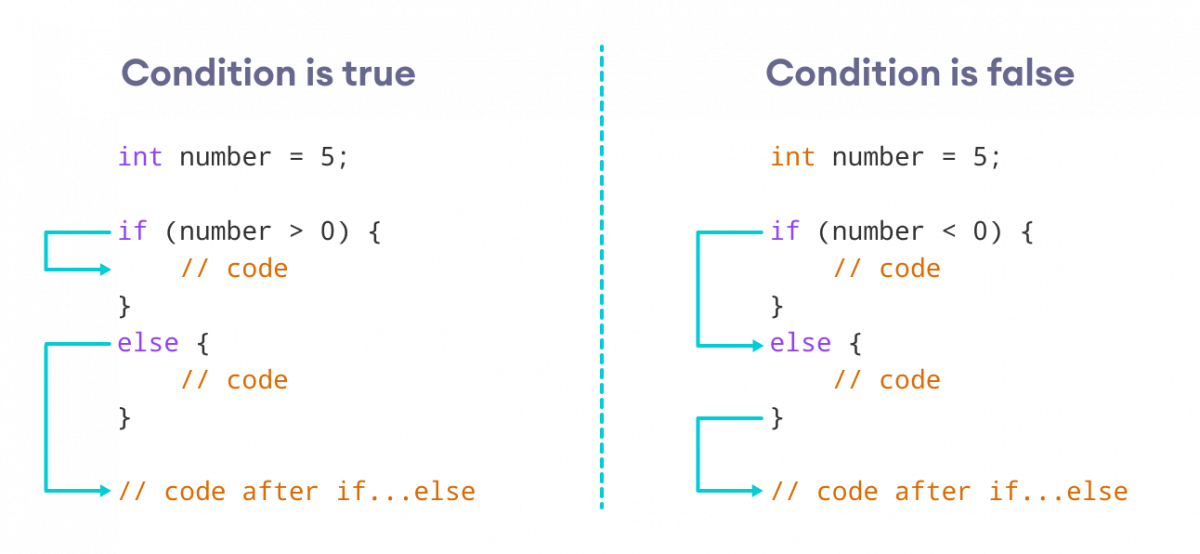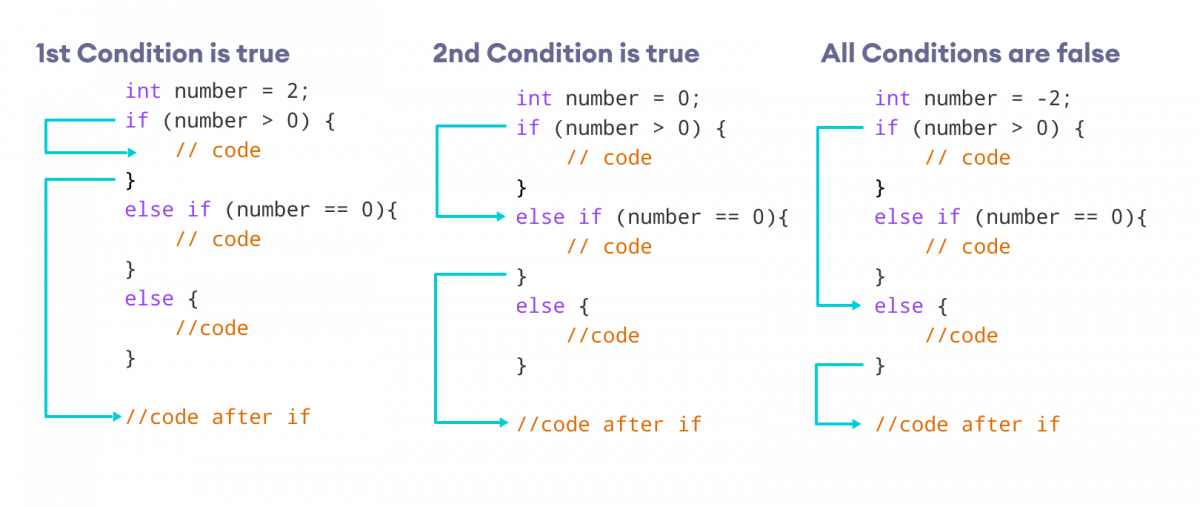C++ の if、if...else およびネストされた if...else
C++ の if, if...else とネストされた if...else
このチュートリアルでは、例を使用して意思決定プログラムを作成する if...else ステートメントについて学習します。
コンピュータ プログラミングでは、if...else を使用します 特定の条件下で 1 つのコード ブロックを実行し、別の条件下で別のコード ブロックを実行するステートメント。
たとえば、学生が取得した点数に基づいて成績 (A、B、C) を割り当てます。
- パーセンテージが 90 を超える場合 、評価 A を割り当てます
- パーセンテージが 75 を超える場合 、評価 B を割り当てます
- パーセンテージが 65 を超える場合 、グレード C を割り当てます
if...else には 3 つの形式があります C++ のステートメント。
if 声明if...else 声明if...else if...else 声明C++ if ステートメント
if の構文 ステートメントは:
if (condition) {
// body of if statement
}
if ステートメントは condition を評価します 括弧内 ( ) .
conditionの場合trueに評価されます 、ifの本体内のコード 実行されます。conditionの場合falseに評価されます 、ifの本体内のコード スキップされます。
注: { } 内のコード if の本体です

例 1:C++ の if ステートメント
// Program to print positive number entered by the user
// If the user enters a negative number, it is skipped
#include <iostream>
using namespace std;
int main() {
int number;
cout << "Enter an integer: ";
cin >> number;
// checks if the number is positive
if (number > 0) {
cout << "You entered a positive integer: " << number << endl;
}
cout << "This statement is always executed.";
return 0;
} 出力 1
Enter an integer: 5 You entered a positive number: 5 This statement is always executed.
ユーザーが 5 を入力したとき 、条件 number > 0 true に評価されます if の本体内のステートメント 実行されます。
アウトプット 2
Enter a number: -5 This statement is always executed.
ユーザーが -5 を入力したとき 、条件 number > 0 false に評価されます および if の本文内のステートメント 実行されません。
C++ if...else
if ステートメントにはオプションの else を含めることができます 句。その構文は次のとおりです:
if (condition) {
// block of code if condition is true
}
else {
// block of code if condition is false
}
if..else ステートメントは condition を評価します

condition の場合 true を評価します 、
ifの本体内のコード 実行されますelseの本体内のコード 実行からスキップされます
condition の場合 false を評価します 、
elseの本体内のコード 実行されますifの本体内のコード 実行からスキップされます
例 2:C++ の if...else ステートメント
// Program to check whether an integer is positive or negative
// This program considers 0 as a positive number
#include <iostream>
using namespace std;
int main() {
int number;
cout << "Enter an integer: ";
cin >> number;
if (number >= 0) {
cout << "You entered a positive integer: " << number << endl;
}
else {
cout << "You entered a negative integer: " << number << endl;
}
cout << "This line is always printed.";
return 0;
} 出力 1
Enter an integer: 4 You entered a positive integer: 4. This line is always printed.
上記のプログラムでは、条件 number >= 0 があります。 . 0以上の数値を入力すると の場合、条件は true と評価されます .
ここでは、4 と入力します .したがって、条件は true です .したがって、 if の本体内のステートメント 実行されます。
アウトプット 2
Enter an integer: -4 You entered a negative integer: -4. This line is always printed.
ここでは、-4 と入力します。 .したがって、条件は false です .したがって、 else の本体内のステートメント 実行されます。
C++ の if...else...else if ステートメント
if...else ステートメントは、2 つの選択肢の間でコードのブロックを実行するために使用されます。ただし、2 つ以上の選択肢から選択する必要がある場合は、if...else if...else を使用します。
if...else if...else の構文 ステートメントは:
if (condition1) {
// code block 1
}
else if (condition2){
// code block 2
}
else {
// code block 3
} ここで、
- If
condition1trueに評価されます 、code block 1実行されます。 - If
condition1falseに評価されます 、次にcondition2評価されます。 - If
condition2trueです 、code block 2実行されます。 - If
condition2falseです 、code block 3実行されます。

注: 複数の else if が存在する可能性があります ステートメントですが、if は 1 つだけです そして else
例 3:C++ の if...else...else if
// Program to check whether an integer is positive, negative or zero
#include <iostream>
using namespace std;
int main() {
int number;
cout << "Enter an integer: ";
cin >> number;
if (number > 0) {
cout << "You entered a positive integer: " << number << endl;
}
else if (number < 0) {
cout << "You entered a negative integer: " << number << endl;
}
else {
cout << "You entered 0." << endl;
}
cout << "This line is always printed.";
return 0;
} 出力 1
Enter an integer: 1 You entered a positive integer: 1. This line is always printed.
アウトプット 2
Enter an integer: -2 You entered a negative integer: -2. This line is always printed.
アウトプット 3
Enter an integer: 0 You entered 0. This line is always printed.
このプログラムでは、ユーザーから番号を取得します。次に if...else if...else を使用します はしごを使って、数値が正か負かゼロかを確認します。
数値が 0 より大きい場合 、 if 内のコード ブロックが実行されます。数値が 0 未満の場合 、 else if 内のコード ブロックが実行されます。それ以外の場合、else 内のコード ブロックが実行されます。
C++ ネストされた if...else
if を使用する必要がある場合もあります 別の if 内のステートメント 声明。これは、ネストされた if として知られています。
if の複数のレイヤーと考えてください ステートメント。最初の外側の if があります ステートメントであり、その内部には別の内部 if があります 声明。その構文は次のとおりです:
// outer if statement
if (condition1) {
// statements
// inner if statement
if (condition2) {
// statements
}
} 注:
elseを追加できます とelse if内部ifへのステートメント 必要に応じて声明- 内側の
ifステートメントは外側のelseの中に挿入することもできます またはelse ifステートメント (存在する場合) ifの複数のレイヤーをネストできます
例 4:C++ のネストされた if
// C++ program to find if an integer is positive, negative or zero
// using nested if statements
#include <iostream>
using namespace std;
int main() {
int num;
cout << "Enter an integer: ";
cin >> num;
// outer if condition
if (num != 0) {
// inner if condition
if (num > 0) {
cout << "The number is positive." << endl;
}
// inner else condition
else {
cout << "The number is negative." << endl;
}
}
// outer else condition
else {
cout << "The number is 0 and it is neither positive nor negative." << endl;
}
cout << "This line is always printed." << endl;
return 0;
} 出力 1
Enter an integer: 35 The number is positive. This line is always printed.
アウトプット 2
Enter an integer: -35 The number is negative. This line is always printed.
アウトプット 3
Enter an integer: 0 The number is 0 and it is neither positive nor negative. This line is always printed.
上記の例では、
- ユーザーからの入力として整数を受け取り、それを変数 num に格納します .
- 次に
if...elseを使用します num が0と等しくないかどうかをチェックするステートメント .- If
true、次に内側if...elseステートメントが実行されます。 - If
false、outer 内のコードelse条件が実行され、"The number is 0 and it is neither positive nor negative."が出力されます
- If
- インナー
if...elseステートメントは、入力数値が正かどうか、つまり num かどうかをチェックします 0 より大きい .- If
trueの場合、数値が正であることを示すステートメントを出力します。 - If
false、数値が負であることを出力します。
- If
注: ご覧のとおり、ネストされた if...else ロジックを複雑にします。可能であれば、ネストされた if...else を常に避けるようにしてください。 .
ステートメントが 1 つだけの if...else の本体
if...else の本体の場合 { } は省略できます。 プログラムで。たとえば、
int number = 5;
if (number > 0) {
cout << "The number is positive." << endl;
}
else {
cout << "The number is negative." << endl;
} と
int number = 5;
if (number > 0)
cout << "The number is positive." << endl;
else
cout << "The number is negative." << endl; 両方のプログラムの出力は同じになります。
注: { } を使用する必要はありませんが if...else の本体の場合 { } を使用して、ステートメントが 1 つだけあります コードが読みやすくなります。
意思決定の詳細
特定の状況では、三項演算子 if...else を置き換えることができます 声明。詳細については、C++ 三項演算子をご覧ください。
与えられたテスト条件に基づいて複数の選択肢から選択する必要がある場合、switch ステートメントを使用できます。詳細については、C++ スイッチにアクセスしてください。
詳細については、次の例をご覧ください:
数値が偶数か奇数かをチェックする C++ プログラム
文字が母音か子音かをチェックする C++ プログラム。
3 つの数の中から最大の数を見つける C++ プログラム
C言語



